Abstract
A lipid hydroperoxide-resistant mutant was isolated from a strain ofSaccharomyces cerevisiae. The mutant was resistant to 1.5mm tert-butylhydroperoxide and 1.0mm linoleic acid hydroperoxide. It flocculated in a Ca2+-dependent manner and the resistance against lipid hydroperoxide was suppressed by mannose, which also inhibited flocculation. A positive relationship between the acquirement of, the flocculent phenotype and resistance against lipid hydroperoxide is suggested. A protein with a molecular weight of 33 kDa was found on the surface of the mutant cell.
Similar content being viewed by others
References
Ames, B.N. 1983 Dietary carcinogens and anticarcinogens. Oxygen radicals and degenerative diseases.Science 221. 1256–1264.
Borgeat, P., Hamberg, M. & Samuelsson, B. 1976 Transformation of arachidonic acid and homo-γ-linoleic acid by rabbit polymorphonuclear leukocytes. Monohydroxy acids from novel lipoxygenase.Journal of Biological Chemistry 251, 7816–7820.
Cerutti, P.A. 1985 Peroxidant states and tumor promotion.Science 227 375–381.
Christman, M.F., Storz, G. & Ames, B.N. 1989OxyR, a possible regulator of hydrogen peroxide-inducible genes inEscherichia coli andSalmonella typhimurium, is homologous to a family of bacterial regulator proteins.Proceeding of the National Academy of Science of the United States of America 86, 3484–3488.
Hodgson, J.A., Berry, R.D. & Johnston, J.R. 1985 Discrimination of heat and proteinase treatment between flocculent phenotypes conferred onSaccharomyces cerevisiae by the genesFLO1 andFLO5.Journal of General Microbiology,131, 3219–3227.
Inoue, Y., Ichiryu, T., Yoshikawa, K., Tran, L.-T., Murata, K. & Kimura, A. 1990 Induction of glutathione peroxidase by linoleic acid hydroperoxide inHansenula mrakii.Agricultural and Biological Chemistry 54, 3289–3293.
Kornfeld, R. & Ferris, C. 1975 Interaction of immunoglobulin glycopeptides with concanavalin A.Journal of Biological Chemistry 250, 2614–2619.
Laemmli, U.K. 1970 Cleavage of structural proteins during the assembly of the head of bacteriophage T4.Nature 227, 680–685.
Lipke, P.N. & Hull-Pillsbury, C. 1984 Flocculation ofSaccharomyces cerevisiae tup1 mutants.Journal of Bacteriology 159, 797–799.
Mariorino, M., Coassin, M., Roveri, A. & Ursini, F. 1989 Microsomal lipid peroxidation: effect of vitamin E and its functional interaction with phospholipid hydroperoxide glutathione peroxidase.Lipids 24, 721–726.
Mallucci, L. 1971 Binding of concanavalin A to normal and transformed cells as detected by immunofluorescence.Nature, New Biology 233, 241–244.
Matsuda, Y., Satho, T., Beppu, T. & Arima K. 1976 Purification and properties of Co2+ requiring heme protein having lipoxygenase activity fromFusarium oxysporum.Agricultural and Biological Chemistry 40, 963–976.
Miki, B.A., Poon, N.H., James, A.P. & Seligy, V.L. 1982a Possible mechanisms for flocculation interactions governed by geneFLO1 inSaccharomyces cerevisiae.Journal of Bacteriology 150, 878–889.
Miki, B.A., Poon, N.H. & Seligy, V.L. 1982b Repression and induction of flocculation interactions inSaccharomyces cerevisiae.Journal of Bacteriology 150, 890–899.
Nugteren, D.H. 1975 Arachidonate lipoxygenase in blood platelets.Biochimica et Biophysica Acta 380, 299–307.
Porter, N.A., Lehman, L.S., Weber, B.A. & Smith, K.J. 1981 Unified mechanism for polyunsaturated fatty acid autoxidation. Competition of peroxyradical hydrogen atom abstraction, β-scission, and cyclization.Journal of the American Chemical Society 103, 6447–6455.
Rose, A.H. 1984 Physiology of cell adhesion: flocculation bySaccharomyces cerevisiae as a model system. InMicrobial Adhesion and Aggregation, ed Marshall, K.C. pp. 323–355. Berlin: Springer-Verlag.
Storz, G., Tartaglia, L.A. & Ames, B.N. 1990 Transcriptional regulator of oxidative stress-inducible genes: direct activation by oxidation.Science 248, 189–194.
Terao, J. & Matsushita, S. 1981 Analysis of photosensitized oxidation products of unsaturated triglycerides and vegetable oils by gas chromatography-mass spectrometry.Agricultural and Biological Chemistry 45, 601–608.
Ursini, F., Mariorino, M., Hochstein, P. & Ernster, L. 1989 Microsomal lipid peroxidation: mechanisms of initiation. The role of iron and iron chelators.Free Radical and Biological Medicine 6, 31–36.
Watari, J., Takata, Y., Ogawa, M., Murakami, J. & Koshino, S. 1991 Breeding of flocculent industrialSaccharomyces cerevisiae strains by introducing the flocculation geneFLO1.Agricultural and Biological Chemistry 55, 1547–1552.
Watari, J., Takata, Y., Ogawa, M., Nishikawa, N. & Kamimura, M. 1989 Molecular cloning of flocculation gene inSaccharomyces cerevisiae.Agricultural and Biological Chemistry 53, 901–903.
Yonetani, T. 1970 Cytochrome c peroxidase.Advances in Enzymology 33, 309–335.
Author information
Authors and Affiliations
Rights and permissions
About this article
Cite this article
Inoue, Y., Tran, L.T., Yoshikawa, K. et al. Phenotypic character of the lipid hydroperoxide-resistant mutant: Positive relationship between flocculation and resistance against lipid hydroperoxide inSaccharomyces cerevisiae . World J Microbiol Biotechnol 8, 296–300 (1992). https://doi.org/10.1007/BF01201883
Revised:
Accepted:
Issue Date:
DOI: https://doi.org/10.1007/BF01201883




